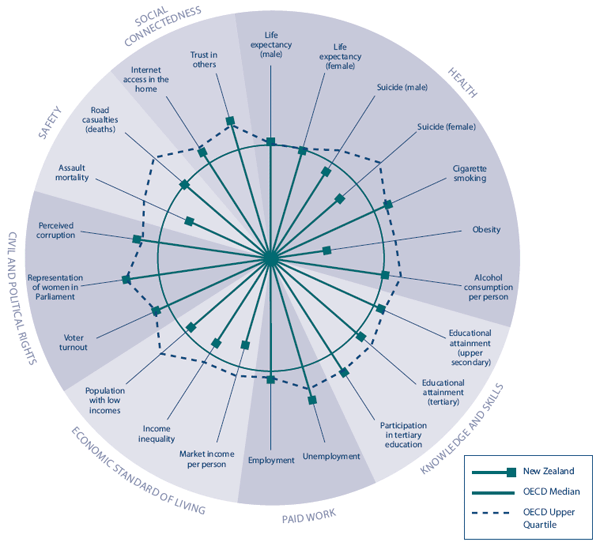Social wellbeing in New Zealand compared to OECD countries
Wellbeing in New Zealand compares favourably to that of other OECD countries
For many indicators, New Zealand compares very well with other countries. New Zealand is at or above the OECD median for two-thirds of the 22 indicators for which there is internationally comparable data.
New Zealand performs extremely well in the Civil and Political Rights domain. New Zealand consistently has one of the lowest levels of perceived corruption in the OECD; in 2007 we had the lowest level of perceived corruption along with Denmark and Finland. New Zealand is in the top half of the OECD for the proportion of women in Parliament and for voter turnout.
Paid Work is another area in which New Zealand performs strongly, with a relatively high employment rate and a relatively low unemployment rate. In 2007, our unemployment rate was fourth lowest in the OECD and we had the sixth highest employment rate.
New Zealand also performs very well in the Social Connectedness area, with New Zealanders having a high level of trust in others and a high level of households with internet access.
In the area of Knowledge and Skills, New Zealand is above the OECD median for the proportion of adults who have at least upper secondary school qualifications, for those who have a bachelor’s degree or higher, and for participation in tertiary education among 20–29 year olds.
In the Health domain, New Zealand’s results are mixed. Our life expectancy is similar to the OECD median, although there is a relatively narrow range of outcomes across the OECD for this indicator. New Zealand’s cigarette smoking rate and per capita consumption of alcohol are slightly better than the OECD median. Our obesity rate is similar to those of Australia and the United Kingdom, lower than that of the United States, but higher than the reported rates in most of the other OCED countries that use a less robust measurement method. We have relatively high suicide death rates.
New Zealand’s rate of road deaths is about the same as the OECD median, while New Zealand’s assault mortality rate was higher than the OECD median using data from 2001–2003.
Our Economic Standard of Living results tend to be lower than those in many OECD countries. In 2004, New Zealand was near the middle of the OECD for population with low incomes and was higher than the OECD median for income inequality. In 2006, New Zealand was below the OECD median for market income per person.
Figure IC1 Social wellbeing in New Zealand, relative to the OECD

|

